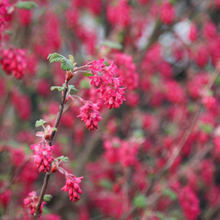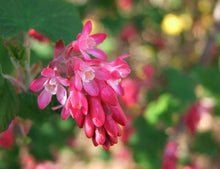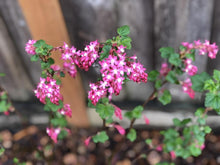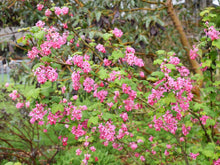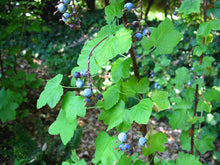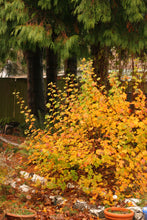
Ribes sanguineum
Equally adored by hummingbirds and habitat gardeners, red flowering currant is a large deciduous shrub with year-round landscape appeal. In early spring, the entire shrub explodes with prolific tubular flowers, ranging from pale pink to bright magenta and even deep red, which are an important food source for queen bumblebees. By summer, the flowers turn into round blue-black berries enjoyed by songbirds. It holds onto its attractive autumn foliage later than most plants, providing excellent winter cover for wildlife.
- Plant type/canopy layer: deciduous, perennial, large shrub
- Size at maturity: 4-12' tall, 6-10' wide
- Light requirements: full sun, part sun/part shade
- Moisture requirements: dry to moist soil, prefers well-drained
- Bloom time: January - July (March - April in the Portland Metro area)
- Growth rate/ease: medium growth rate, easy to grow
- Wildlife support: flowers are an important early source of food for hummingbirds, acting as beacons for the migrating Rufous hummingbird, and attract other bird species such as bushtits; the flowers are also a source of nectar and pollen for early-emerging insect pollinators—notably queen bumblebees; ripe berries attract and are food for small mammals and many bird species such as cedar waxwings and robins; the leaves are a larval food source for the zephyr (Polygonia gracilis zephyrus), Ceanothus silkmoth (Hyalophora euryalus), and other butterfly and moth larvae, which in turn feed insectivorous birds; overall its large, multi-stemmed form is excellent cover for birds and other wildlife
- Native habitat/range: common on open rocky slopes, forest edges and disturbed sites at low to middle elevations, from the coast to the cascades, from southwest British Columbia through Washington, Oregon, and into central California. Portland Plant List - yes.
- Special features & uses: wildlife favorite, including hummingbirds; edible but bland; landscape uses include pollinator gardens and rock gardens, erosion control and hedgerows
Gardening with Red Flowering Currant: This no-fuss shrub requires at least 4hrs of sun per day and well-drained soils. It will tolerate clay soils, but not if they are poorly draining. It is very useful for erosion control on challenging slopes and intermixed with other native evergreen shrubs in a hedgerow. Exceptionally drought tolerant once established.
Photo Credit 1: "Blut-Johannisbeere (Ribes sanguineum)" by blumenbiene is licensed under CC BY 2.0
Photo Credit 2: "Blut-Johannisbeere (Ribes sanguineum)" by Harald52 is licensed under CC BY-ND 2.0
Photo Credits 3: Tara Lemezis, Tiny Seed Photography
Photo Credit 4: Nikkie West, Sparrowhawk Native Plants
Photo Credit 5: "Ribes sanguineum" by chuck b. is licensed under CC BY 2.0
Photo Credit 6: Karli Del Biondo, Beetles and Bees






